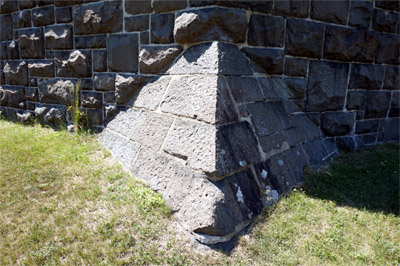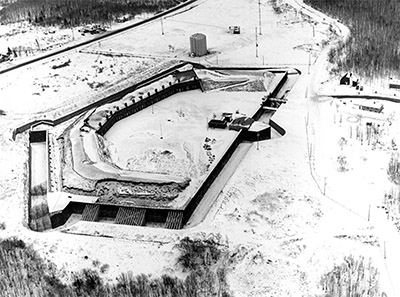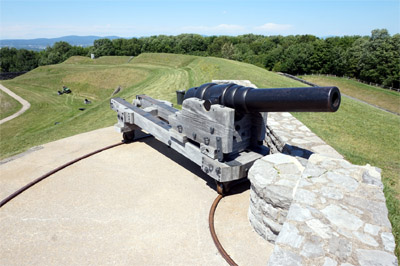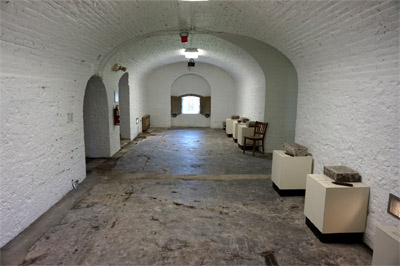 |
Fort No. 1
Lévis, Québec, Canada
|
|
 |
Constructed: 1865 - 1872
Used by: Great Britain, Canada
Conflict in which it participated:
None
|
In the early 1860's, British Canada had a problem. That problem was the American Civil War (1861-1865), which was playing out in a furious fashion to its south...occasionally disturbingly close to its borders.
Though Great Britain was officially neutral in this conflict, the cotton that the Confederacy produced was vital to Britain's textiles industry, and trade betwixt the two nations continued despite the Federal Government of the United States' blockade and ban against such activity. Added to this were such events as the Trent Affair, which edged the United States and Great Britain ever closer to war. |
 |
|
|
At this time there was already a semi-distinguished history of folks from the south attacking Quebec. During the Seven Years' War (1856-1763), Quebec was part of New France. British forces led by General James Wolfe (1727-1759) defeated the French under Louis-Joseph de Montcalm (1712-1759) at the Battle of the Plains of Abraham (September 13, 1759), just outside the walls of Quebec City (following a three-month-long bombardment of the city from across the St. Lawrence River at Pointe-Lévy, the general location at which the fort of our current interest would be built just over a century later). This battle hastened the end of New France, and more directly ended the lives of both Wolfe and Montcalm, the latter of whom was starfort royalty, in that he initiated the construction of Fort Carillon in 1755. This fort was captured by the British in 1759, renamed, and is now known as superstarfort Fort Ticonderoga. And, American forces invaded Quebec in 1775, as part of the ongoing American Revolutionary War (1775-1783). The Battle of Trois Rivières (June 8, 1776) was the culmination of America's attempt to snatch Quebec and the Saint Lawrence River from British control, and did not end well for the gentlemen of the starry Thirteen Colonies. |
 The leading edge of Fort No. 1's caponniere, the first pointy thing that American troops approaching from the east would notionally be pierced by. The leading edge of Fort No. 1's caponniere, the first pointy thing that American troops approaching from the east would notionally be pierced by. |
 |
Given this reatively recent history, it's easy to understand how the British, whose military strength in Canada was most definitely at a low ebb due to Canada's independence movement of the mid-19th century, would be concerned about America's intentions.
Time to build a starfort! Or a flankless fort, as this style of polygonal fort was called by the British in this age. Call it what you want, it's still a starfort for all intents and purposes: Three bastions covering its leading edge, and a caponniere watching over the back door.
But with a name like "Fort No. 1," surely one by now suspects that this was but the first in a series of forts? |
|
So prescient are thee. During the period in question, the art of artillery had advanced to such a stage that the classic starfort configuration of defense was considered passé. Forts that had been thought to be at the leading edge of technological defensification were being defeated by advanced gunnery time and again in the US Civil War (the fates of Fort Sumter, Fort Pulaski and Fort Macon were three such cases), and the next generation of defensive fortification was on the rise. |
The concept of the "discontinuous fortified ring," which gained favor in the latter half of the 19th century, was that a series of individual forts, built in a ring around the city in need of defense, would essentially serve the same function as the bastions of a starfort.
Spaced out to a distance based on the perceived abilities of the latest artillery, armed with guns and infantry, these fortlets were intended to hold an attacking army at an extent from their goal, so that the city in question could not be bombarded. These individual forts would be close enough to be mutually supporting, and their crossfire would make incursion betwixt them a bloody business.
|
 |
 Y'know what Quebec has? It has snow. Y'know what Quebec has? It has snow. |
|
One of the aspects of this system of defense that made it attractive to nations with an expectation of being attacked was its relative economy: Though building a series of forts was certainly expensive, such an endeavor was far cheaper than constructing an unbroken line of masonry, batteries and earthworks that would have had to be many miles in length.
|
 An alert 18cm Armstrong Gun, facing the east, the most likely direction from which red, white 'n' blue trouble might emenate. An alert 18cm Armstrong Gun, facing the east, the most likely direction from which red, white 'n' blue trouble might emenate. |
 |
"Cheap" or not, Canada's British authorities had no interest in building new defenses for Québec City on their own. The British had, after all, put together a gorgeous starfort a mere 30 years previously to protect Québec City, in the Citadelle de Québec. Yes, it was essentially just a reworking of the pre-existing French fort, but still, how many forts do you need, Québec?! While the British Royal Engineers were to be responsible for the construction of what would become Fort No. 1, civilian contractors under the direction of Royal Engineers would build Forts No. 2 and 3. The forts were to be spaced just over a mile apart from one another, with No. 1 situated on the highest point, overlooking the city. |
|
A Fort No. 4 was briefly considered, likely to fill the gap represented in the map at the top of this page, but ground was never broken for a Fuerte Numero Quatro, as it would not have been known.
Forts No. 1, 2 and 3 were all begun in 1865 and, perhaps unsurprisingly, the two forts built by civilian contractors were finished years before the military-constructed Fort No. 1. All three forts were of similar design and size, though not identical...nonetheless, Fort No. 1 wasn't completed until 1872.
|
Fort No. 1 was surrounded with a 16'-deep ditch, which was covered by flank howitzers in each of the fort's caponnieres, as well as loopholes from whence the garrison could fire their rifles at any unhappy attackers who had made it into the ditch. The fort was designed to mount twenty big guns, and there were thirteen brick casemates under the terreplein, in which the garrison would be housed and/or be protected whilst under bombardment.
Before Fort No.1 was even completed, however, international events rendered it moot. On July 1, 1867, the British colonies of Ontario, Quebec, Nova Scotia and New Brunswick were officially confederated into a nation called "Canada," and the military of Great Britain (mostly) departed from the Canadian/US border region.
|
 |
 One of Fort No. 1's flank howitzers. One of Fort No. 1's flank howitzers. |
|
Solidifying this change was the Treaty of Washington (1871), which settled a number of disputes betwixt the US and Great Britain stemming from the US Civil War. Seemingly overnight, the threat of a US invasion of Canada evaporated.
Which left Forts No. 1, 2 and 3 sitting there, collectively pointless. None of the forts was ever garrisoned, though each received a single 7-inch breechloading Armstrong Gun in 1878. These guns were mounted, but everyone suddenly realized that the forts were facing the wrong way, as coverage of the St. Lawrence River would be a more sensible defensive precaution now that the threat of a landward invasion was over (although a defensive precaution against what exactly is unclear: River pirates?).
|
 Inside some of Fort No. 1's nifty casemates are a series of kid-friendly exhibits concerning the working of stone. Inside some of Fort No. 1's nifty casemates are a series of kid-friendly exhibits concerning the working of stone. |
 |
Forts No. 1, 2 and 3 were officially deactivated in 1905. Still owned by the government, Fort No. 1 was used during the First (1914-1918) and Second (1939-1945) World Wars as a munitions depot, as well as for housing troops on their way to Europe.
In November of 1947, the Canadian Department of Defense turned these three forts over to the Department of Mines and Resources. Whatever else this latter Department accomplished, it was not concerned with maintaining old forts: Fort No. 2 was overbuilt with a shiny insurance building, while No. 3 was razed to build a concrete factory.
Fortunately, a program to restore and stabilize Fort No. 1 was begun in 1972. |
|
Fort No. 1 was opened to the public in 1982 as an historic site. In 1983, Canada Post released a set of stamps featuring ten of Canada's impressive fortifications in the Forts Across Canada series. Fort No. 1 was included in this collection.
|
|
|
|
|
|
 |




